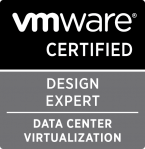For people that need to make practice for the VCAP-DCA exam (and the beta of VCAP5-DCA will start soon) a good lab environment is mandatory. But it could also be useful for other reasons, like demo environment.
There are several options to build one, but most used solutions are using nested hosts on one physical system with:
- VMware Workstation/Fusion over a host OS: common for a notebook.
- ESXi 5 on a server or a whitebox: common if you plan to have a always-on or fixed solution.
Actually both solution could be good, but Workstation could not scale too much, expecially if you work with a notebook. For whitebox configurations there are several site (I just suggest this post: Home vLab: my new WhiteBox). But you can also consider a good server (latest are really quite and powerful).
But what about the virtual environment of the virtual hosts and the virtual storage?
Some days ago I’ve seen an interesting project called vSphere 5 Auto Lab that is is a quick and easy way to build a vSphere environment for testing and learning using a single desktop or laptop PC and VMware Workstation, Fusion or ESXi. The whole lab runs in VMs on that one PC, even ESXi runs in a VM and can then run it’s own VMs.
What’s in the AutoLab?
The Autolab download contains a set of shell VMs and a lot of automation. Once built the lab contains two ESXi servers, a Windows Active Directory Domain controller, a Windows Virtual Center, a FreeNAS storage appliance and a FreeSCO Router to link it to the outside world.
Is really interesting how the VM are configured (there are one version for ESXi and one for Workstation) and also how are deployed.
The hardware requirements for the lab are moderate. Hopefully you won’t need to buy a new computer, although you may need to do some upgrades. If you can dedicate a computer to the role then the lab runs extremely well under ESXi.
| Hardware | Minimum | Great Choice | Used to build the lab (laptop bought in 2009) |
| CPU | Dual Core, 64Bit | Quad Core, i7 | Core2 Duo |
| RAM | 8GB | How much can you afford? | 8GB |
| Hard Disk | 60GB free space | 120GB SSD free space | Second SATA hard disk, Laptop OS on small SSD |
| Operating System | 64 Bit | ESXi 5.0 | Windows 7 64Bit |
| Virtualization Software | VMware Player (untested) | ESXi 5.0 | VMware Workstation 8.0.2 |
Hint for the ESXi nested solution
If you use an ESXi host you can use two unique feature:
- Transparent Page Sharing (see also KB 1021095) that can reduce the needed memory.
- The vmdk sharing: usable to build a guest cluster, but also a cluster with ESXi nodes without the need of iSCSI or NFS appliances (same functions was explained to build a virtual XenServer Pool).
Hint for the Workstation nested solution
In Workstation you have a unique feature that permit to make a linked clone from a VM snapshot (to be host there is also in vSphere but is not directly usable from the GUI… for example it is used in VMware View or vCloud Director). In this way you can reduce the footprint of similar VMs and also reduce number of different blocks that you must access (this make possible run the environment on a SSD or just use better the cache).











